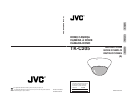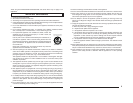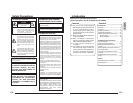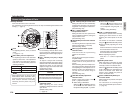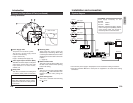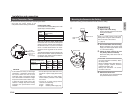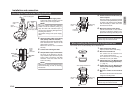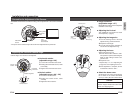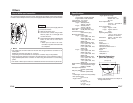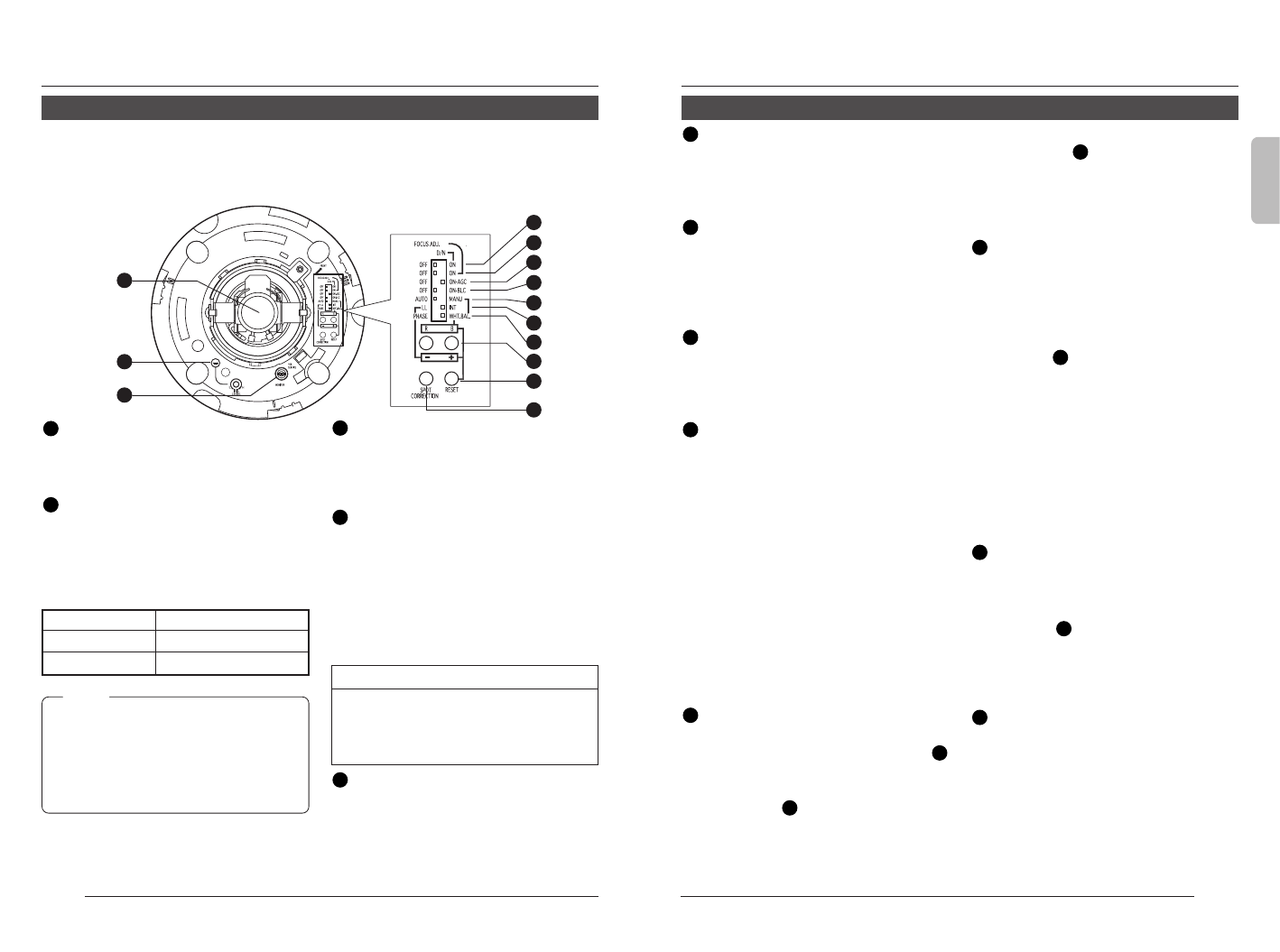
E-6
Names and Operations of Parts
Introduction
3
MONITOR terminal (RCA pin)
For connecting a monitor when mount-
ing the camera for adjusting the lens or
determining the camera angle. (High im-
pedance)
4
[D/N - ON/OFF] Easy Day & Night
switch
To capture a subject with continually
changing brightness (day/night), set this
switch to “ON.” The camera automatically
captures the image in color when the
subject is bright, and in black and white
mode when it is dark.
(Default setting: OFF)
5
[FOCUS ADJ. - ON/OFF] focus
adjustment switch
When adjusting the focus during
installation, setting this switch to “ON” will
open the iris.
(Default setting: OFF)
( ੬ page 15)
11
9
4
5
6
7
8
12
13
3
2
1
10
Ⅲ Body Surface
View when the dome cover is removed.
For instructions on removing the dome cover, see step 4 of “Mounting the Camera to the
Ceiling”. ( ੬ page 11)
Turning direction of level
To darken image Counterclockwise (L side)
To brighten image Clockwise (H side)
1
Head
For adjusting the lens, focus, or camera
angle.
( ੬ page 14 ~ 15)
2
[IRIS LEVEL] Iris level adjustment
For adjusting the level of the automatic
aperture control lens. This adjustment
only needs to be made when required.
Use this to accommodate particular
shooting conditions.
MEMO
•When adjusting the iris level, set the
AGC switch to “OFF”. Otherwise, when
the level is turned too far toward L, the
AGC function activates increasing
sensitivity and the picture may look
uneven.
CAUTION
The Easy Day & Night feature on this cam-
era uses a sensitized black and white
mode unlike other black and white surveil-
lance cameras that use infra-red lighting.
E-7
English
6
[AGC - ON/OFF] Auto-gain control switch
Setting this switch to “ON” automatically
increases the sensitivity even when the
brightness of the subject is insufficient.
(Default setting: ON)
7
[BLC - ON/OFF] Backlight
compensation switch
Setting this switch to “ON” opens the iris
even in backlight conditions, making the
subject easier to view.
(Default setting: OFF)
8
[AUTO/MANU] Auto/manual selection
switch
For selecting whether to adjust the white
balance automatically or manually.
(Default setting: AUTO)
9
[INT/LL] Synchronization system
selection switch
This switch sets the synchronizing
system for the camera.
INT:
This is set for internal synchronization
LL (Line Lock):
The camera’s vertical synchronization is
locked to the AC 24 V power line fre-
quency.
When switching between multiple cam-
eras using a switcher, selecting this mode
and adjusting the vertical phase can re-
duce the monitor sync disturbances oc-
cur that when the camera image is
switched.
(Default setting: INT)
10
[WHT.BAL/PHASE] adjustment
selection switch
Switch to select the function of the
11
[R/B. +/–] adjustment button.
Ⅲ When setting to WHT.BAL:
When the
8
[AUTO/MANU] switch is
set to MANU, the white balance can
be adjusted using the [R/B, +/–] button.
Ⅲ When setting to PHASE:
When the
9
[INT/LL] switch is set to
LL, the vertical phase of the line lock
can be adjusted using the [R/B, +/–]
button.
(Default setting: WHT.BAL)
11
[R/B, +/–] adjustment button
This button is pressed when manually
adjusting the white balance or when
adjusting the vertical phase of the line
lock.
The function of this button is selected
using the
10
[WHT.BAL/PHASE] switch.
Ⅲ When manually adjusting the white
balance:
Press the R button to increase the red
tint and decrease the blue tint.
Press the B button to increase the blue
tint and decrease the red tint.
Ⅲ When adjusting the phase:
Press the + or – button to adjust the
phase.
12
[RESET] Reset button
When this button is pressed, the value
of the white balance or phase adjusted
manually is reset to the default value.
When the
10
[WHT.BAL/PHASE] switch
is set to WHT.BAL, the white balance is
reset to the default value. When the
switch is set to PHASE, the phase is
reset to the default value.
13
[SPOT CORRECTION] White-spot
correction button
When this button is pressed, white spots
are corrected.
For instructions on correcting white-
spots, see “About White-spot correction”.
( ੬ page 16)



